Elon Musk’s satellites are ruining the view of space telescopes: ‘It’s getting worse’
Up to 6% of the observations made with the ‘Hubble’ are being spoiled by the Starlink network, which will multiply tenfold its number of satellites in the sky with the deployment of mega-constellations
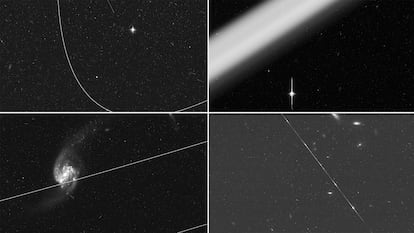
At first glance, one may assume that the images were damaged by a technical glitch: distant galaxies with streaks that cut through them, blank stripes that cover half the picture, lines that dirty entire constellations. But all those astronomical observations, that have been spoiled for science, actually reveal a problem: how the skies are being increasingly filled with artificial satellites from internet companies like Elon Musk’s Starlink. The swarms of devices were already a problem for ground-based observatories, but a recent study found that they also ruin observations from space telescopes, something that is raising concern among astronomers. In 2021, 5.9% of the images captured by the legendary Hubble telescope suffered from this photobombing caused by these artifacts’ trails.
That same year (when the study’s last measurement was taken) Starlink had deployed about 1,900 satellites. Today, they are close to 3,600, and the number is expected to multiply by 10 – and to reach 100,000 in total, counting those deployed by the competition – by the end of this decade. In recent times, observatories have expressed great concern regarding the mega-constellations of satellites that Starlink and other companies, like OneWeb or Amazon, are deploying in the skies. The International Astronomical Union (IAU) has called for measures to be taken, as they will “saturate the modern detectors [of] large telescopes,” and the Spanish Astronomical Society considers them “a threat to astronomical observation.” So much so, that they have taken their complaint to the United Nations, and the commission for space affairs is studying how to put a stop to it.
The surprise, however, is that they are already causing considerable damage to space telescopes like the Hubble, launched into orbit precisely to avoid interference from both the atmosphere and human activities, such as communication noise and light pollution. From up there, they have a clear celestial vault and a direct view of space... or so they did, until now. “This is the first time that this problem for the Hubble has been quantified,” said astronomer Bruno Merín from the European Space Agency (ESA), co-author of the study published by Nature Astronomy. “The most notable thing, what we want to raise awareness about, is that this problem also affects space telescopes,” he pointed out.
A 50% increase
“We see a clear growth in the incidence. There is a 50% increase in trails observed in 2021,” Merín said. The study analyzed the images captured by the telescope between 2002 and 2021; on average, satellites ruined 2.7% of all the observations made in that period. However, Starlink only started deploying its convoys in 2019. “We don’t know what the impact of the mega-constellations will be,” Merín said. Their study actually started as an attempt to find the asteroids that the Hubble detected by chance, and that is when they found the trouble caused by satellites: there were twice as many trails left behind by machines than space rocks (3,228 vs. 1,701).
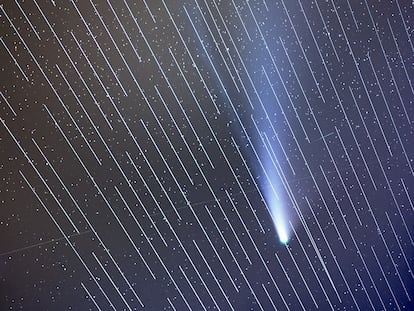
The problems are real and are already causing major harm. A 2020 study reported one of the galaxies closest to the Big Bang. Afterward, however, other scientists assured that the measurements had been nothing but the result of a satellite’s glow. Whatever it was, this is a perfect example of how all the science that depends on these observations is in trouble.
At this rate, we will have to go to the Moon
José María Diego is one of the astronomers who, a year ago, discovered Earendel, the most distant star ever observed, thanks to observations from the Hubble telescope. “This problem has been going on for years and is getting worse now, because the number of satellites flying around is multiplying,” explained Diego, from the Cantabria Institute of Physics, in Spain. “It’s a problem without an easy solution: we’re going to have to live with it, and it’s only going to get worse. I say this half jokingly, but we’re going to have to go and observe from the hidden side of the Moon,” he added.
In reality other types of telescopes are the most affected. “Radio astronomers are doing worse,” Diego explained, “because satellites not only reflect light; they also emit waves that make them a constant problem.” These emissions also jeopardize weather forecasts, meteorologists warned.
“The images from optical telescopes are more damaged when satellites reflect light at dawn and dusk, in the first and last lights of the day,” Diego explained. In a study conducted at one observatory, scientists found that ruined twilight images went from less than 0.5% at the end of 2019 to 18% in August 2021 – just around the time of Starlink’s deployment. Astronomers are used to automatically cleaning up these messes, and often make several observations to avoid taking chances.
Diego pointed out that there have been some changes, “reactive initiatives from the scientific community.” Thanks to their complaints, less reflective materials are being used to make satellites, or they are being painted black. “But the solar panels are still a problem, because they cannot be painted, and they shine,” he explained. Faced with widespread pressure – also from US government agencies – Elon Musk has promised to try to minimize the impact of his activities, after years of ignoring the situation.
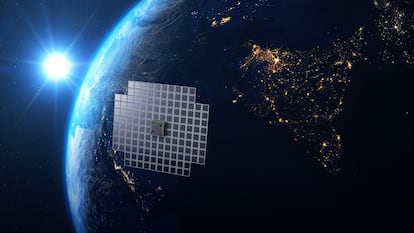
Starlink assures that it will provide astronomers with orbital information so that observatories can avoid their satellites as much as possible. However, until international standards are established, there is no guarantee that all the companies that are planning mega-constellations will act with restraint. Because Starlink’s satellites are not alone. In September 2022, SpaceX launched the giant BlueWalker-3, an eight-by-eight-meter-wide satellite property of the internet company AST SpaceMobile, which, being as bright as the shiniest star in the sky, is easily visible from the ground.
The IAU has lobbied at the United Nations for the Committee on the Peaceful Uses of Outer Space to set up a technical group to establish international guidelines that apply to all countries, given that what an American company does, for example, affects an international collaboration such as the Hubble telescope. According to Science, the IAU, together with delegations from Chile, Spain and South Africa (where important telescopes are located) have four months to reach a consensus proposal.
And space observation is not the only thing that is put at risk by the space gold rush. The US Federal Aviation Administration wants to issue SpaceX a $175,000 fine for having launched 53 Starlink satellites in August 2022 without submitting a collision-avoidance analysis.
Sign up for our weekly newsletter to get more English-language news coverage from EL PAÍS USA Edition
Tu suscripción se está usando en otro dispositivo
¿Quieres añadir otro usuario a tu suscripción?
Si continúas leyendo en este dispositivo, no se podrá leer en el otro.
FlechaTu suscripción se está usando en otro dispositivo y solo puedes acceder a EL PAÍS desde un dispositivo a la vez.
Si quieres compartir tu cuenta, cambia tu suscripción a la modalidad Premium, así podrás añadir otro usuario. Cada uno accederá con su propia cuenta de email, lo que os permitirá personalizar vuestra experiencia en EL PAÍS.
¿Tienes una suscripción de empresa? Accede aquí para contratar más cuentas.
En el caso de no saber quién está usando tu cuenta, te recomendamos cambiar tu contraseña aquí.
Si decides continuar compartiendo tu cuenta, este mensaje se mostrará en tu dispositivo y en el de la otra persona que está usando tu cuenta de forma indefinida, afectando a tu experiencia de lectura. Puedes consultar aquí los términos y condiciones de la suscripción digital.
More information
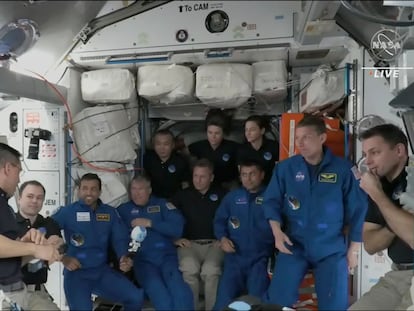
New crew from US, Russia and UAE arrives at space station
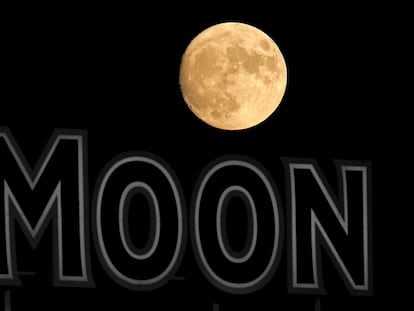
What time is it on the Moon? Europe pushing for lunar time zone
Archived In
Últimas noticias
Most viewed
- Sinaloa Cartel war is taking its toll on Los Chapitos
- Oona Chaplin: ‘I told James Cameron that I was living in a treehouse and starting a permaculture project with a friend’
- Reinhard Genzel, Nobel laureate in physics: ‘One-minute videos will never give you the truth’
- Why the price of coffee has skyrocketed: from Brazilian plantations to specialty coffee houses
- Silver prices are going crazy: This is what’s fueling the rally









































